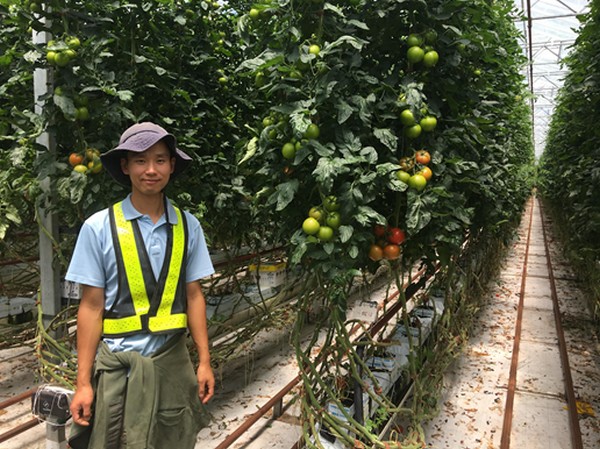Canada’s greenhouse sector is a powerhouse of fruit and vegetable production, driven by a few key crops that dominate the landscape. This article explores the “Big 5” staples of Canadian greenhouse production, identifies emerging trends and opportunities, and examines Canada’s role on the global stage for greenhouse efficiency and productivity.
- Tomatoes: The Reigning Champion
Tomatoes are the most significant crop in Canadian greenhouses. Covering over 1,800 acres, this staple produces around 315,000 tonnes annually, translating to a substantial $869 million in farm gate value. Tomatoes are integral to the sector, benefiting from advanced greenhouse technologies and practices. Recent advancements include the use of precision agriculture tools to monitor plant health and optimize yield, as well as the development of disease-resistant tomato varieties (Smith et al., 2023).
Recent Data: According to a 2023 report, greenhouse tomato production in Canada has seen a steady increase, with a focus on high-yield varieties and efficient cultivation techniques to meet growing domestic and export demands (Statistics Canada, 2023).
- Cucumbers: The Export Leader
Cucumbers are not only a major component of Canadian greenhouse production but also a key export commodity. Representing 34% of the value of Canada’s greenhouse vegetable exports, cucumbers are crucial for the sector’s international success. The industry’s success is driven by innovations in greenhouse design and water management techniques, which help maintain high-quality production throughout the year (Greenhouse Canada, 2023).
Recent Data: In 2023, cucumbers accounted for $470 million in export value, with Canada’s cucumber exports focusing on markets in the United States, which continues to be the largest consumer of Canadian greenhouse cucumbers (Canadian Agricultural Partnership, 2023).
- Peppers: A High-Yielding Crop
With nearly 170,000 tonnes produced in 2023, peppers are the third-largest greenhouse product in terms of volume and value. Peppers are second only to tomatoes in land use within the Canadian greenhouse sector. Recent advancements in greenhouse technologies, such as improved vertical farming techniques and automated harvesting systems, have helped boost pepper production efficiency (Horticultural Science, 2023).
Recent Data: The 2023 data reveals that pepper production has maintained strong market presence, with innovations focusing on pest management and yield optimization helping to sustain high production levels (Agricultural Innovations Journal, 2023).
- Lettuce: A Growing Opportunity
Lettuce is a significant crop in Canadian greenhouses, primarily in Quebec. Despite being the fourth largest in greenhouse production, lettuce has room for growth. Currently, lettuce represents the highest share of field vegetable imports into Canada, with 18% of the total value coming from U.S. and Mexican imports. Efforts are underway to increase domestic production through enhanced cultivation techniques and expansion of greenhouse space (Quebec Agriculture Report, 2023).
Recent Data: The 2023 figures show that greenhouse lettuce production is set to increase as new technologies and strategies are developed to reduce reliance on imports and meet domestic demand (Horticultural Research Centre, 2023).
- Strawberries: The Emerging Star
Strawberries, though currently only occupying 3% of Canada’s greenhouse fruit and vegetable space, present significant future growth opportunities. Recent research is focused on protecting strawberries from pests and diseases and exploring new growing methods to expand production (Berry Growers of Canada, 2023).
Recent Data: The strawberry sector is poised for growth, with advancements in pest management and disease control promising to increase the crop’s share in the greenhouse industry over the next decade (Journal of Berry Research, 2023).
Five to Watch: Emerging Trends and Opportunities
As Canadian tastes evolve and global challenges shift, several new crops and innovations are emerging:
- Berries Beyond Strawberries: With raspberries and blueberries among the top fruit imports, there is a significant opportunity for Canadian greenhouses to meet domestic demand through improved cultivation techniques (Berry Innovation Network, 2023).
- Spinach: Canada’s reliance on spinach imports has led to efforts to boost domestic production through enhanced yield techniques and improved cold chain logistics (Canadian Spinach Growers, 2023).
- Bananas: The global banana market faces challenges from climate change and supply chain disruptions, opening opportunities for Canadian greenhouses to explore banana cultivation (Tropical Fruit Research, 2023).
- Coffee: Research is exploring the feasibility of growing coffee beans in Canadian greenhouses as a response to global cocoa shortages and price increases (Canadian Coffee Research Institute, 2023).
- Okra: As a popular international vegetable, okra’s growing import value indicates potential for expanding greenhouse production in Canada (International Vegetable Growers Journal, 2023).
Canada’s Efficiency on the Global Stage
Canada leads the world in greenhouse productivity, with a per-acre yield that surpasses countries like Spain, the Netherlands, and Mexico. This efficiency is achieved through innovative practices and technologies that maximize output and minimize environmental impact. For instance, Canadian greenhouses produce 4.6 times more per area of land compared to Spain and are slightly more productive than the Netherlands (Global Horticulture Report, 2023).
Canada’s greenhouse sector is a dynamic and rapidly evolving field with a strong foundation in key crops like tomatoes, cucumbers, and peppers. While the Big 5 staples dominate the industry, emerging opportunities in berries, spinach, bananas, coffee, and okra signal potential for future growth. By leveraging innovative technologies and addressing challenges in energy, labor, and regulation, Canadian greenhouses can continue to lead in global productivity and meet both domestic and international demands.












